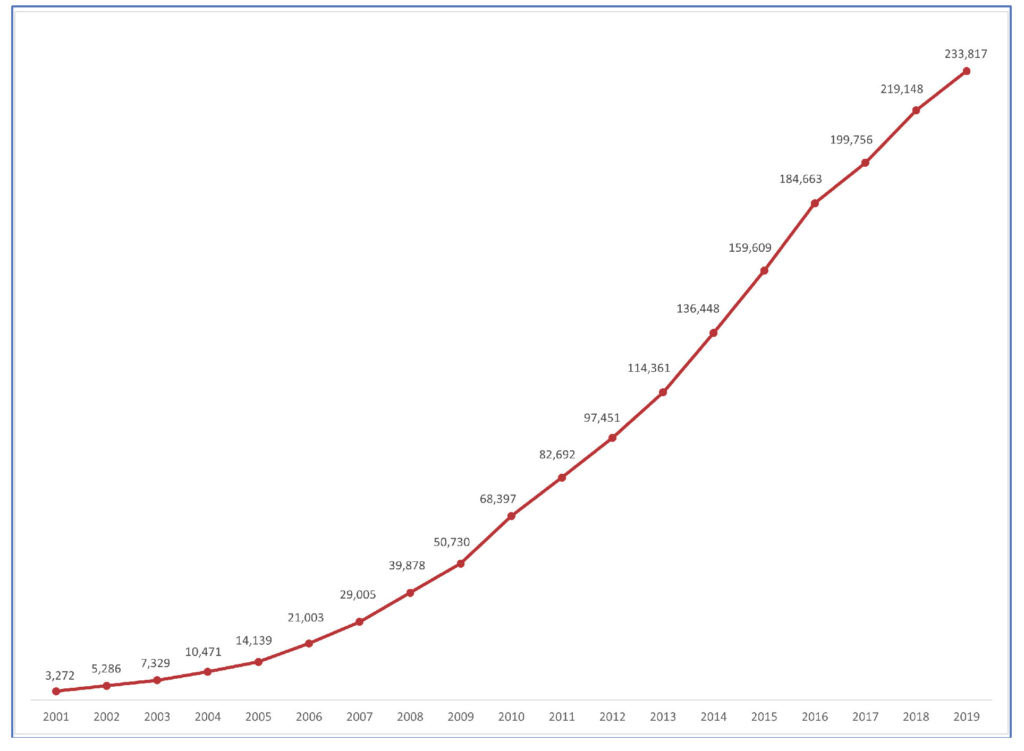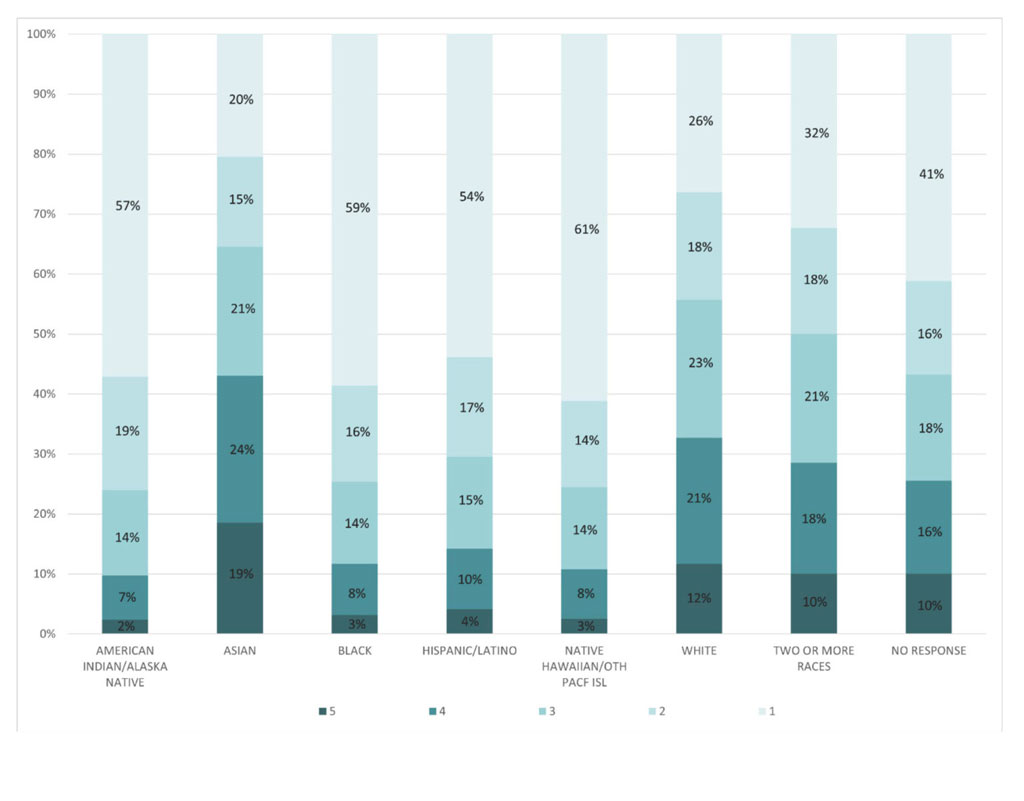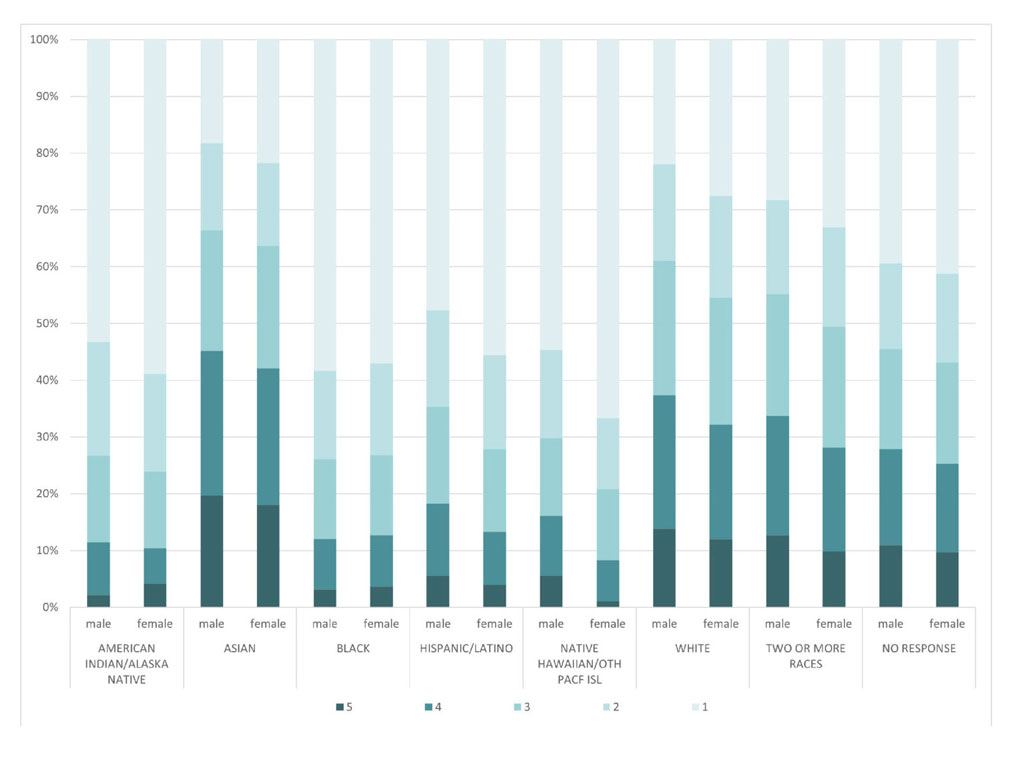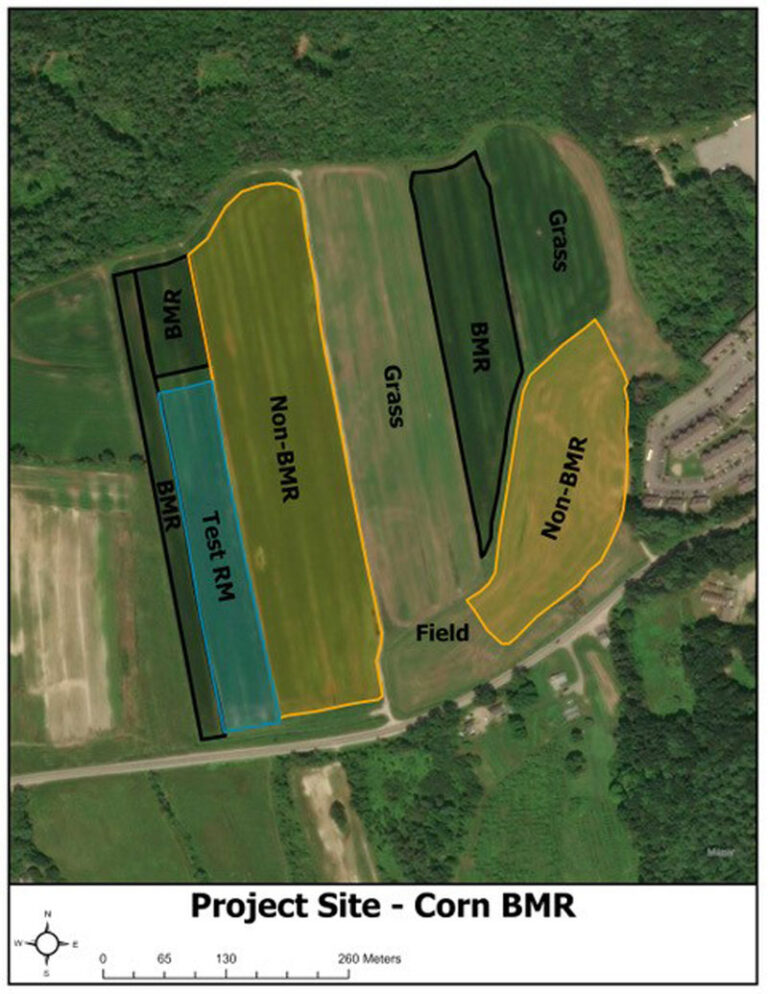Advanced Placement Human Geography: Time for a Reappraisal?
By Michael Solem, Ph.D.; Dr. Richard G. Boehm, Ph.D.; and Joann Zadrozny, Ph.D.
Gilbert M. Grosvenor Center for Geographic Education, Department of Geography and Environmental Studies, Texas State University
Two decades on, the Advanced Placement Human Geography (APHG) course continues its upward trajectory in student enrollment. In recent years, well over 200,000 high school students took the APHG exam, marking an impressive period of growth since it was first offered in 2001 (Figure 1).

Even geographers who have paid cursory attention to APHG are likely to be familiar with this growth curve from the high publicity it receives. The immediate takeaway is of a College Board program providing tens of thousands of students with the opportunity to take a rigorous geography course in high school.
Much has been written about the purported benefits of student participation in APHG. In practical terms, students can receive college credit hours with a passing mark on the APHG exam (a score of at least 3 on a 5-point scale).1 APHG students are considered by many geographers to be recruitable majors, or at least likely to take more geography courses as an undergraduate. Given the perennial stress placed by low undergraduate course enrollments on many geography departments, it is a small wonder that the growth in APHG is commonly viewed by geographers as a success story.
Yet as former AAG President Dave Kaplan notes in a recent article appearing in The Professional Geographer, this growth coincided with a 12.4% decrease in conferred undergraduate geography degrees from 2013-2018.2 At present, we do not know how many students receiving APHG credit take additional geography courses across the country. A national tracking study would be challenging to execute, but it would certainly provide some clarity about one of the potential benefits of offering APHG in high schools.
Until then, one of the things we can be sure about is the considerable amount of revenue generated by APHG’s skyrocketing growth. In the U.S. the exam cost per student is $96, though lower fees are available for students eligible for free or reduced-price lunch. Additional revenues are associated with supplemental exam prep and tutorial fee payments. APHG’s growth curve must also look good from the perspective of textbook companies and authors whose works are adopted by schools offering the course.
There are other facts about APHG that we believe should be openly and honestly discussed among geographers and the leadership of our organizations. The conversation we need requires a shift in perspective from growth metrics to quality metrics, so that we begin to acquire a clear understanding of the things that really matter: the extent that APHG is effective for the students who participate in the course and whether APHG is delivering on its potential for geography in higher education.
In this column, we would like to initiate this conversation by sharing a preview of research currently underway here in the Gilbert M. Grosvenor Center for Geographic Education. Earlier this year, we organized a team of researchers to help us analyze APHG exam score distributions by geographic setting (state by state as well as by urban, suburban, and rural school districts), student demographics, and grade level over the entire history of APHG. For comparison, the team is also analyzing student exam scores for cognate courses in the AP program.
APHG, growth, and inequality in student outcomes
In 2019, 50.8% of all students who took the APHG exam failed to earn a passing score; only the AP Physics I course has a lower success rate in the entire AP program. In his PG article, Kaplan explains (p.614),3
One of the reasons behind this relatively low rate of success comes from the fact that two thirds of all students take APHG in ninth grade. This is highly unusual for AP exams; no other exam comes even close.
Indeed, no other AP course has over 10% of 9th graders except for Computer Science Principles (11%) and Chinese Language and Culture (16%). In fact, most other AP courses have less than 1% of tests taken in the 9th grade.4 In his article, Kaplan explains that “schools have decided that human geography is a good stepping-stone to the AP experience and provide the exam with little competition at that grade level” (614).
What are the educational consequences of an administrative decision to make APHG a warmup course for high school students? Michael Scholz, an Associate Professor at Winona State University, is the lead author of a study that investigated the relationship of taking APHG in high school with college students’ relative interest in majoring or minoring in geography and pursuing a geography career.5 In a survey completed by 2,397 undergraduate students at Texas State University, Scholz found an association between higher interest in geography and taking APHG in 11th or 12th grade, especially when students also took other geography and honors-level geography courses in high school. Interest levels in geography and geography careers were much lower among college students who took APHG in the 9th grade.
Citing research indicating a students’ self-efficacy in a subject is an important predictor of their interest in that subject, Scholz argues:
Since 9th grade students do not perform as well as students in higher grade levels on the APHG exam, it is more likely that 9th grade students’ self-efficacy is negatively impacted and therefore they are less likely to be interested in geography, taking geography courses, majoring or minoring in geography, or pursuing a career in geography (77).
In his article, Kaplan also discusses the persisting underrepresentation of women and minorities in the geography discipline and workforce. This is another area where APHG could potentially make a big difference for students and geography departments, especially given recent research that confirms most 8th graders are not proficient in geography and that there are widespread gender and racial gaps in geography achievement.6 Few states require geography for high school graduation, which raises the stakes for APHG to act as a crucial and positive point of student engagement with geography.
However, it appears APHG as presently organized and implemented is doing little to reduce disparities in student outcomes in U.S. geography education. Compared with White and Asian students in the 9th and 10th grades,7 the failure rate (percentage of students scoring 1 or 2) in APHG is 20% higher among American Indian/Alaska Native, Black, Hispanic/Latino, and Native Hawaiian/Other Pacific Islander students (Figure 2). Apart from Black male students, male students outperformed female students in APHG within every racial and ethnic group (Figure 3).
Another way to look at the inequality in APHG is to compare the demographics of 9th/10th grade APHG students with the proportion of students who scored 1 or 2 on the exam in those grades (Table 1). The proportion of APHG exams taken in 2019 by White and Asian students was higher than the fraction of those students who scored a 1 or 2 on the exam. In contrast, Black and Hispanic/Latino students comprise a higher percentage of students who scored a 1 or 2 on the APHG exam relative to their composition of the test takers in 2019.


Table 1. APHG participation and outcomes by race and ethnicity in the 9th/10th grades, 2019.
| Race/ethnicity
|
Number of 9th/10th grade APHG students | Percent of total 9th/10th grade APHG exams | Percent of total 9th/10th grade APHG exam scores 1 or 2 |
| American Indian | 708 | 0.4 | 0.5 |
| Asian | 22,980 | 12.0 | 8.1 |
| Black | 14,787 | 7.8 | 10.9 |
| Hispanic/Latino | 47,808 | 25.1 | 33.4 |
| Native Hawaiian/
Other Pacific Islander |
314 | 0.2 | 0.2 |
| White | 90,219 | 47.3 | 39.6 |
| Two or more races | 8,700 | 4.6 | 4.3 |
| No response | 5,195 | 2.7 | 2.9 |
Allowing students who lack the prerequisite knowledge, writing ability, and other necessary preparation to take a college-level geography course is something we wouldn’t (and shouldn’t) tolerate in our own departments, yet this is exactly what has been happening in high schools for years. And now, by parting the unparted curtains of APHG, we begin to see how the unfettered and often applauded growth of APHG plays out in the form of a lower and inequitable rate of student success.
We recently shared these observations with the education editor of a major newspaper, who responded that 9th grade students may still benefit academically from experiencing an AP course even if they score a 1 or 2 on the exam. Other educators remain deeply concerned about the insufficient number of highly qualified AP teachers and the defeatism observed among students who fail the exam.8
In our view, the AAG and other geography organizations should ask schools to scale back APHG offerings in the 9th grade to a level that is consistent with other AP subjects. The priority moving forward should be research into student outcomes and how we can effectively provide equitable access to the support systems that foster student success in APHG.
The Grosvenor Center’s APHG research team will present the full results of their studies at the 2022 AAG Annual Meeting in New York. We hope you will join the conversation there and we thank you for considering our perspective.
DOI: 10.14433/2017.0105
Notes
- These credits are only accepted at higher education institutions where the equivalent introductory human geography course is offered.
- Kaplan, D.H. 2021. Geography’s position in education today, The Professional Geographer, 73:4, 608-618, DOI: 1080/00330124.2021.1906922
- We excluded 2020 APHG scores in our analysis because COVID-19 related AP examination changes complicate direct comparisons with earlier years.
- Scholz, M.A., R.W.Scholz, and R.G. Boehm. 2017. Investigating grade level impact of the Advanced Placement Human Geography course and student interests in pursuing geography in higher education. Research in Geographic Education, 19(1): 67-81.
- Solem,, P.W. Vaughan, C. Savage, and A.S. De Nadai, Student- and school-level predictors of geography achievement in the United States, 1994 – 2018. Journal of Geography, https://doi.org/10.1080/00221341.2021.2000009
- The College Board reports APHG exam scores as separate statistics only for 11th and 12th graders, making it necessary to calculate 9th and 10th grade score percentages by subtracting 11th and 12th grade scores from the overall national totals.
- “AP’s Equity Face-Plant.” Ann Kim, Washington Monthly.
Perspectives is a column intended to give AAG members an opportunity to share ideas relevant to the practice of geography. If you have an idea for a Perspective, see our guidelines for more information.


